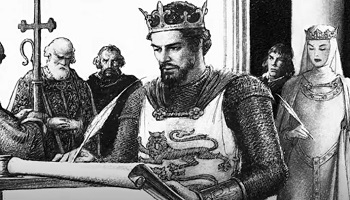
William the Conqueror Net Worth in Today’s Terms
William the Conqueror, a name synonymous with conquest and transformation, is one of history’s most fascinating figures. As the first Norman King of England, his achievements not only reshaped the political and cultural landscape of medieval Europe but also established immense wealth. But how wealthy was William, and what would his fortune look like in today’s economy? This blog dives into William’s wealth, its sources, and how his net worth might be quantified in modern terms.
Who Was William the Conqueror?
Born in 1028 in Falaise, Normandy, William was the illegitimate son of Robert I, Duke of Normandy, earning him the nickname “William the Bastard.” Despite his precarious start, he ascended to power in Normandy at a young age, navigating political intrigue and warfare to solidify his rule.
In 1066, William famously crossed the English Channel with his Norman forces, defeating Harold Godwinson at the Battle of Hastings. This victory earned him the English crown and the title “William the Conqueror.” His reign lasted until 1087, during which he restructured England’s governance, legal systems, and wealth distribution.
The Sources of William’s Wealth
William’s wealth came from various sources that were unique to his time:
- Control of Normandy:
As Duke of Normandy, William inherited and expanded one of the most prosperous regions in Europe. Normandy’s fertile lands, thriving ports, and trade connections provided significant income through agriculture, taxes, and commerce. - Conquest of England:
The victory at Hastings in 1066 marked a turning point in William’s fortunes. As King of England, he claimed ownership of all English lands, redistributing them among his Norman supporters while taxing the native population. - The Feudal System:
William implemented a feudal system in England, where land was granted to lords in exchange for military service and taxes. This system ensured a steady stream of revenue while consolidating his power. - Domesday Book:
In 1086, William commissioned the Domesday Book, a comprehensive survey of England’s lands and resources. This document not only helped him assess his wealth but also enabled efficient tax collection.
How Rich Was William the Conqueror?
Quantifying William’s wealth in precise terms is challenging due to the lack of detailed financial records from the 11th century. However, historians agree that he was one of the wealthiest monarchs of his era.
William’s assets included:
- Vast Landholdings: By claiming ownership of all English lands, William essentially became the largest landowner in Europe. Land was the primary measure of wealth in medieval times, and his holdings stretched across both England and Normandy.
- Tax Revenue: The introduction of the feudal system and the Domesday Book allowed William to collect taxes systematically. This steady income bolstered his treasury.
- Spoils of War: The conquest of England brought immense wealth in the form of plunder, confiscated estates, and increased political leverage.
Translating William’s Wealth into Today’s Economy
To estimate William the Conqueror’s net worth in today’s terms, we must consider factors such as inflation, land value, and the economic significance of his assets. Here’s how his fortune might compare:
- Land Ownership:
At the time of his reign, William controlled nearly all of England’s 32 million acres of land. If valued at today’s average UK farmland price (approximately £7,000 per acre), his landholdings alone would be worth over £224 billion ($280 billion). - Taxation Income:
The annual tax revenue from England under William’s rule has been estimated at around £15,000 in medieval currency. Adjusted for inflation and purchasing power, this could amount to £250 million ($310 million) annually today. - Normandy’s Wealth:
Normandy’s economic contributions would add significantly to William’s net worth. As one of the wealthiest duchies of the time, its trade and agricultural output would likely place his combined wealth above $300 billion when considering both England and Normandy.
William the Conqueror vs. Modern Billionaires
In modern terms, William’s wealth would easily place him among the richest individuals in history. For comparison:
- Elon Musk (2024): Net worth of approximately $230 billion.
- Jeff Bezos (2024): Net worth of around $160 billion.
- William the Conqueror (adjusted): Estimated net worth exceeding $300 billion, making him wealthier than both.
Unlike today’s billionaires, whose fortunes are tied to industries like technology and retail, William’s wealth was rooted in land ownership and political control. His wealth wasn’t just monetary—it represented absolute authority over resources, people, and commerce.
How Did William Use His Wealth?
William’s use of wealth differed significantly from modern billionaires. Rather than investing in businesses or philanthropy, his wealth was primarily directed toward:
- Military Expansion:
Conquering and defending his territories required substantial resources. William’s wealth funded his army, castles, and fortifications, ensuring his dominance. - Administrative Reforms:
The creation of the Domesday Book and the establishment of feudalism were major administrative undertakings that relied on his financial resources. - Religious Contributions:
William was a devout Christian who funded the construction of churches and monasteries. These investments not only secured his spiritual legacy but also reinforced his political authority.
William’s Wealth in Historical Context
While William’s wealth was immense, it’s important to consider its context. Medieval wealth was tied closely to power, with little separation between personal fortune and state resources. This contrasts with today’s billionaires, whose wealth is often personal and independent of governmental control.
Moreover, William’s wealth was instrumental in reshaping England’s political and social structures. His redistribution of land to Norman nobles created a new ruling class, while his taxation policies laid the groundwork for England’s economic development.
What If William Lived Today?
If William were alive in the 21st century, his approach to wealth would likely differ. Here’s how he might operate in today’s world:
- Real Estate Tycoon: As a landowner, William would likely dominate global real estate markets, owning vast properties across continents.
- Political Influence: His control over resources would make him a major political figure, comparable to sovereign wealth funds or oligarchs.
- Historical Investments: Given his interest in legacy, William might fund large-scale cultural and educational initiatives, similar to the philanthropic efforts of modern billionaires.
William the Conqueror’s wealth, when translated into today’s terms, positions him as one of the richest individuals in history. With an estimated net worth exceeding $300 billion, his fortune was a testament to his military success, strategic governance, and control over vast resources.
While modern billionaires accumulate wealth through innovation and commerce, William’s fortune came from conquest, land, and political power. His legacy reminds us that wealth in any era is not just about numbers—it’s about influence, impact, and the ability to shape the world.
In today’s economy, William the Conqueror would not only rival the wealthiest but also wield unparalleled authority, blending historical power with modern economic dominance.



